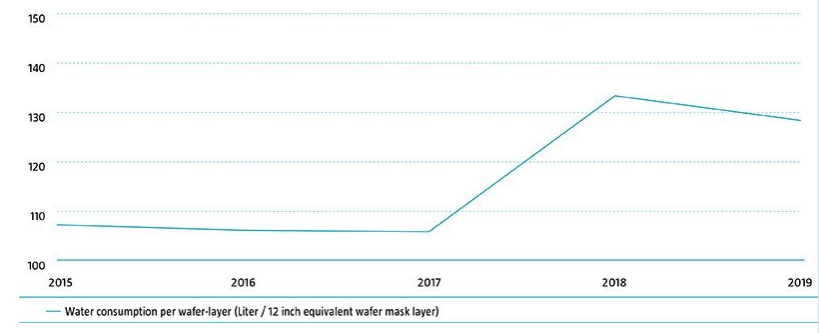What has happened?
212,000,000 liters – that’s how much water TSMC1, one of the world’s leading chipmakers, consumes per day, according to its 2020 Corporate Social Responsibility Report. That would be enough to satisfy the daily water needs of nearly 1.5 million Europeans. Yet it is the amount of water necessary to produce microchips the size of a human fingernail that are embedded in devices all around us.
Making the tiny chips that power billions of electronic devices we use every day is a water-intensive process. The estimated water footprint of a single microchip in a smartphone or laptop can go as high as 30 liters. That figure runs even higher for silicon wafers that contain hundreds of multi-layered microchips. With each additional wafer layer, circuits and conductive material must be chemically etched and meticulously cleaned – processes that require vast amounts of ultra-purified water.
As high as that figure may be now, it will almost certainly move higher, not just for TSMC but for the entire semiconductor industry as the digital economy expands across economic sectors and geographic regions. Figure 1 shows how the volume of water used to manufacture each layer of a 200 mm semiconductor wafer has risen precipitously in the past few years as chips have grown denser and more sophisticated.
Figure 1 : Water and wafers – an upward journey

Source: TSMC, Bloomberg Opinion
“
As global chip production ramps up, water supplies are drawing down to alarmingly low levels
Why does it matter?
As global chip production ramps up, water supplies are drawing down to alarmingly low levels. Taiwan, TSMC’s headquarters and a major semiconductor hub for the world, has been struggling with periodic droughts. The most recent was so bad that earlier in 2021, the government cut water supplies to TSMC and other major tech firms by 15% and said it would stiffen restrictions further if shortages persisted.
To maintain chip production, TSMC chartered trucks to bring in fresh water from other parts of the country. Thanks to these stop-gap extremes, the company was able to, at least temporarily, avert production issues. However, that may change, as global warming continues to upset global weather systems, making droughts more frequent, more prolonged, and more geographically extensive.
Taiwan is not alone in its water worries. Water stress and scarcity are growing increasingly into a global water crisis. Half a billion people live in a state of constant water scarcity and half the world’s population (3.9 billion) experience water scarcity at some point in the year. Population growth, worldwide industrialization, energy production and climate change are all stressing water supplies. The UN estimates that by 2030, global demand for water will exceed supply by 40%.
Nor is TSMC an isolated case among semiconductor producers. Technology hubs are oftentimes located in dry, arid regions, with companies being attracted by the low humidity, cooler temperatures, cheap land and generous subsidies. Popular states for chip factories (or “fabs”) and data centers in the US include Texas, New Mexico, Arizona, California and Oregon. Elsewhere, the distribution of chip fabs and tech hubs show a similar pattern with locations in Israel, Northern China, Singapore – all areas prone to water-stress.
What does this mean for investors?
To ensure uninterrupted water supplies for operations, many deep-pocketed chipmakers such as TSMC and its North American-based rival Intel2 are building their own water treatment plants. These mini-utilities will capture, clean and recycle industrial effluent for re-use in production and cooling processes. TSMC will open a state-of-the-art water treatment plant in the southwestern city of Tainan by the end of 2021 and Intel has invested significantly in on-site water treatment facilities for its fabs in Oregon, Arizona and Israel.
All of this entails investments in pipes, valves and heavy infrastructure, water filtration and cleaning technologies, as well as advanced analytical systems for testing, detecting, and monitoring micropollutants and water quality. Moreover, a surging interest in water investments is not exclusive to semiconductor manufacturers. From metals to mining, textiles to timber, agriculture to automobiles, corporate valuations of water-related assets are changing. Water’s status as a precious resource and critical production factor is finally being recognized. Without water, there would be no industrial output and no economic growth.
For more than two decades, Robeco’s water strategy has been investing in attractive companies providing effective solutions across the water value chain. Our accumulated knowledge and expertise will help investors navigate the road ahead as climate change intensifies the need for investments that help companies, cities and communities use water more efficiently.
Footnotes
1This is not a buy, sell or hold recommendation for any particular security.
2This is not a buy, sell or hold recommendation for any particular security.
免責聲明
本文由荷宝海外投资基金管理(上海)有限公司(“荷宝上海”)编制, 本文内容仅供参考, 并不构成荷宝上海对任何人的购买或出售任何产品的建议、专业意见、要约、招揽或邀请。本文不应被视为对购买或出售任何投资产品的推荐或采用任何投资策略的建议。本文中的任何内容不得被视为有关法律、税务或投资方面的咨询, 也不表示任何投资或策略适合您的个人情况, 或以其他方式构成对您个人的推荐。 本文中所包含的信息和/或分析系根据荷宝上海所认为的可信渠道而获得的信息准备而成。荷宝上海不就其准确性、正确性、实用性或完整性作出任何陈述, 也不对因使用本文中的信息和/或分析而造成的损失承担任何责任。荷宝上海或其他任何关联机构及其董事、高级管理人员、员工均不对任何人因其依据本文所含信息而造成的任何直接或间接的损失或损害或任何其他后果承担责任或义务。 本文包含一些有关于未来业务、目标、管理纪律或其他方面的前瞻性陈述与预测, 这些陈述含有假设、风险和不确定性, 且是建立在截止到本文编写之日已有的信息之上。基于此, 我们不能保证这些前瞻性情况都会发生, 实际情况可能会与本文中的陈述具有一定的差别。我们不能保证本文中的统计信息在任何特定条件下都是准确、适当和完整的, 亦不能保证这些统计信息以及据以得出这些信息的假设能够反映荷宝上海可能遇到的市场条件或未来表现。本文中的信息是基于当前的市场情况, 这很有可能因随后的市场事件或其他原因而发生变化, 本文内容可能因此未反映最新情况,荷宝上海不负责更新本文, 或对本文中不准确或遗漏之信息进行纠正。